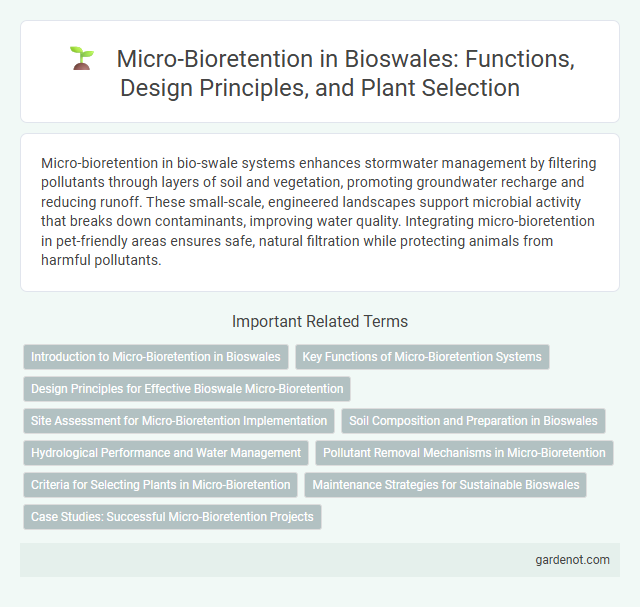Micro-bioretention in bio-swale systems enhances stormwater management by filtering pollutants through layers of soil and vegetation, promoting groundwater recharge and reducing runoff. These small-scale, engineered landscapes support microbial activity that breaks down contaminants, improving water quality. Integrating micro-bioretention in pet-friendly areas ensures safe, natural filtration while protecting animals from harmful pollutants.
Introduction to Micro-Bioretention in Bioswales
Micro-bioretention in bioswales involves engineered shallow basins that capture and treat stormwater through natural processes, enhancing groundwater recharge and pollutant removal. These systems utilize soil media, vegetation, and microbial activity to filter contaminants such as nutrients, heavy metals, and sediments from runoff. Advanced micro-bioretention designs optimize hydraulic retention time and promote microbial degradation, making them effective low-impact development (LID) tools for sustainable urban water management.
Key Functions of Micro-Bioretention Systems
Micro-bioretention systems primarily function to enhance stormwater management by promoting infiltration and pollutant removal through engineered soil media and vegetation. These systems effectively reduce runoff volume, filter suspended solids, and capture nutrients such as nitrogen and phosphorus, improving water quality before it reaches natural water bodies. Key mechanisms include microbial degradation, sedimentation, and adsorption, which together mitigate urban stormwater impacts and support groundwater recharge.
Design Principles for Effective Bioswale Micro-Bioretention
Bioswale micro-bioretention design principles emphasize maximizing pollutant removal through engineered soil media with high infiltration capacity and organic content. Incorporating native vegetation with deep root systems enhances water uptake, soil stability, and microbial activity critical for nutrient cycling. Proper grading and flow path design ensure controlled runoff velocity and sufficient residence time, optimizing sedimentation and infiltration processes.
Site Assessment for Micro-Bioretention Implementation
Site assessment for micro-bioretention implementation requires detailed analysis of soil permeability, existing drainage patterns, and groundwater levels to ensure optimal water infiltration and pollutant removal. Evaluating site slope, land use, and contaminant load is crucial to design an effective bio-swale system that mitigates stormwater runoff impact. Incorporating hydraulic conductivity tests and pollutant load estimation refines the bio-retention cell placement for maximum environmental benefit.
Soil Composition and Preparation in Bioswales
Micro-bioretention in bioswales relies on specialized soil composition designed to maximize infiltration and pollutant removal. A well-prepared soil mix typically includes sandy loam combined with organic matter and engineered amendments like compost or biochar to enhance nutrient retention and microbial activity. Proper soil preparation involves grading and compaction control to ensure optimal hydraulic conductivity and root growth within the bioretention system.
Hydrological Performance and Water Management
Micro-bioretention systems enhance hydrological performance by effectively capturing and filtering stormwater runoff through engineered soil media and vegetation, reducing peak flow rates and improving groundwater recharge. These systems promote water management by facilitating infiltration, decreasing surface runoff volume, and removing pollutants such as nitrogen, phosphorus, and suspended solids. Their design optimizes detention time and hydraulic conductivity, contributing to sustainable urban drainage and mitigating flooding risks.
Pollutant Removal Mechanisms in Micro-Bioretention
Micro-bioretention systems utilize vegetation, soil media, and microbial activity to effectively remove pollutants such as heavy metals, nutrients, and organic compounds from stormwater. Pollutant removal mechanisms in micro-bioretention include physical filtration, adsorption to organic matter, and microbial degradation, which break down contaminants into less harmful substances. Enhanced microbial colonization within the root zone accelerates nitrogen removal through nitrification and denitrification processes, improving overall water quality.
Criteria for Selecting Plants in Micro-Bioretention
Plants in micro-bioretention systems must have deep root systems to enhance soil permeability and support microbial activity for pollutant removal. Selecting native species with high tolerance to fluctuating moisture levels ensures resilience and long-term survival in bio-swales. Vegetation should also exhibit rapid growth and dense foliage to maximize sediment capture and evapotranspiration benefits.
Maintenance Strategies for Sustainable Bioswales
Micro-bioretention systems require regular inspection to maintain optimal infiltration rates and prevent clogging by sediment or debris. Implementing scheduled removal of accumulated sediments and periodic replacement of filter media enhances the longevity and efficiency of bioswales. Proper maintenance strategies, including vegetation management and monitoring of hydraulic performance, ensure sustainable stormwater treatment and promote groundwater recharge.
Case Studies: Successful Micro-Bioretention Projects
Micro-bioretention systems effectively manage urban stormwater by filtering pollutants and reducing runoff volume, as demonstrated in Washington D.C.'s Anacostia River Project, which achieved a 50% reduction in nitrogen loads. The Seattle RainWise Program showcases the integration of micro-bioretention with green infrastructure, resulting in improved water quality and enhanced groundwater recharge. Case studies consistently highlight micro-bioretention's role in mitigating urban flooding while providing ecological benefits through native vegetation and microbial activity.
Micro-bioretention Infographic

 gardenot.com
gardenot.com